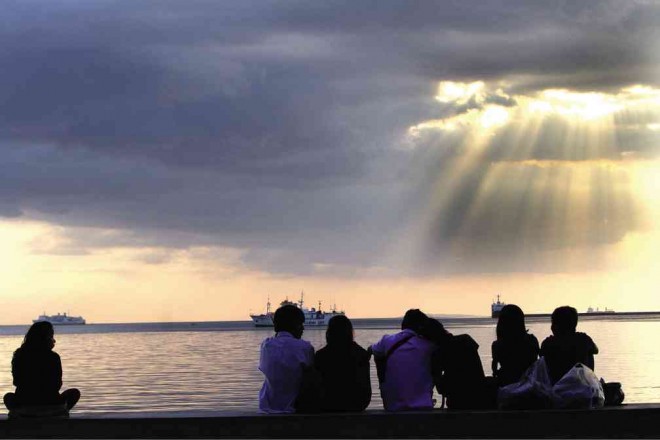New surge of opposition vs Manila Bay reclamation

OPPONENTS of reclamation projects want Manila Bay left as it is, unobstructed by potential danger zones in an age of intensifying typhoons and storm surges. JOAN BONDOC
A Manila councilor is calling on colleagues to oppose reclamation projects on the city’s portion of Manila Bay and restore the ban that lasted for 18 years before it was lifted in 2011.
In a draft resolution, Councilor Ali Atienza, whose father Lito Atienza upheld the ban during his three terms as Manila mayor, said “interfering with Mother Nature would be hazardous, and would have far-reaching environmental consequences to Metro Manila and its neighboring suburbs.”
The young Atienza called for the repeal of City Ordinance No. 8233, which was passed during the administration of then Mayor Alfredo Lim. By lifting the ban set by Ordinance No. 7777, it allowed the city government in 2012 to enter into a contract with Manila Goldcoast Development Corp. to reclaim and develop 148 hectares of the bay.
The project is part of a national reclamation plan that will also cover the cities of Pasay, Parañaque, Las Piñas and Bacoor (in Cavite province), where advocacy groups and environmentalists had gone to court to oppose similar projects.
The resolution was filed days before Manila hosted a public hearing on the Goldcoast project, during which critics doubted whether multimillion-peso developments that alter natural coastlines could withstand typhoons that are becoming increasingly strong like Supertyphoon “Yolanda.”
Article continues after this advertisementArticle continues after this advertisement
Seawalls 5 meters high
The hearing held on Monday allowed stakeholders to scrutinize Goldcoast’s pending application for an environmental compliance certificate (ECC), a crucial government requirement, for its envisioned commercial, residential and tourism hub called “Solar City.”
Goldcoast representatives allayed fears that the project would be courting catastrophe similar to what happened in Tacloban City, saying it would have 5-meter-high seawalls designed to mitigate the effects of storm surges of Yolanda’s scale.
But Dr. Kelvin Rodolfo, a marine geology expert opposing the project, said the lack of comprehensive data on storm surges was enough reason to doubt if an effective defense against them could be engineered.
A storm surge is an abnormal rise in water level caused primarily by strong winds due to the presence of a typhoon or hurricane. Tacloban City and other parts of Visayas suffered the wrath of storm surges unleashed by Yolanda in the form of 5- to 6-meter-high walls of water that came crashing on coastal settlements and deep into urban centers. In 2011, Manila was also battered by a storm surge caused by Typhoon “Pedring.”
“If reclamation is done properly, it can actually help the coastline be resilient to storm surges,” said Blair Spendelow, section head for marine modeling of DHI Singapore, an independent environmental consultant hired by Goldcoast to assess the impact of reclamation and identify engineering solutions against floods and storm surges.
But Rodolfo, professor emeritus of the Department of Earth and Environmental Sciences at University of Illinois in Chicago, said: “How can you properly engineer if you don’t know the forces you are trying to contain? Even if you know now what you’re up against, what is it going to be like 20 or 30 years from now?”
Potential loss of life
“The problem is, they’re thinking of profits and not concerned with what happens afterwards. They don’t care about the potential loss of life,” he said.
Goldcoast vice chair Edmundo Lim said SM Mall of Asia, which stands on reclaimed land in Pasay City, was not flooded during the onslaught of Pedring in 2011 because a Belgian company put up seawalls with wave reflectors, unlike the areas of Roxas Boulevard, the US Embassy and Sofitel hotel, which had no proper seawall.
Edmundo Lim said the future Solar City would have seawalls as high as 5 m and the buildings would be strong enough to withstand an intensity-8 earthquake.
“If we design buildings in such a way that water can move around the building, it won’t be flooded,” Spendelow added.
But Rodolfo countered: “All of the earlier reclamations worsened flooding, how can this be any different? Water wants to flow to the sea, if you have buildings in the way, you’re making it harder for water to flow to the sea.”
“Goldcoast proposes to challenge nature, to change the shoreline by bulging out into the sea with an artificial erection. Mother Nature will respond by ceaselessly wearing it away,” Rodolfo said.
Nature’s preference
Nature, he said, wants to make straight shorelines.
Underscoring the income and jobs that the Solar City would generate, the Goldcoast presentation cited successful reclamation projects in other countries. But Rodolfo said that unlike those in the Philippines, almost all the cited examples were located far from seismic faults.
Should the company secure an ECC from the Department of Environment and Natural Resources, the project proposal will be reviewed by the Office of the President and then sent back to the Philippine Reclamation Authority.
Groups such as the Malate-based Alyansa ng Mamamayan Laban sa Reklamasyon and the Archdiocese of Manila Ministry on Ecology had expressed opposition to the Goldcoast project.
“Hundreds of hectares have been reclaimed in Manila Bay since the 1970s and no comprehensive impact evaluation has been done even if the areas within the vicinity have experienced massive flooding,” the groups said in a position paper presented during Monday’s hearing.